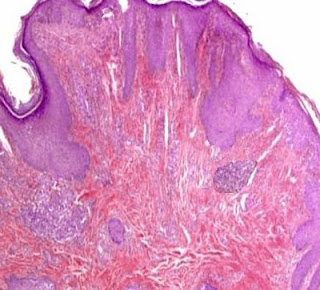Answer of Dermatopathology Case 41
Fibrous Papule of the Face (Fibrous Papule of the Nose) Visit: Dermatopathology site Abstract: Solitary Oral Fibromas of the Tongue Show Similar Morphologic Features to Fibrous Papule of the Face: A Study of 31 Cases. Am J Dermatopathol. 2010 Apr 24. The morphologic similarities between fibrous papules of the face and multiple oral fibromas were mentioned long ago, mainly in the context of phakomatoses. Both lesions have been considered to be different types of angiofibromas. Nonetheless, this interpretation is not accepted by all authors. We tried to investigate if solitary oral fibromas also share morphologic features with fibrous papules of the face. For this purpose, we designed a retrospective study retrieving 31 fibromas of the tongue from 30 different patients and studied a control group of 20 fibrous papules of the face from 20 different patients. From the oral fibromas, 15 lesions presented as dome shape, whereas 16 lesions presented as polypoid. Lesion size varied between 2 a

